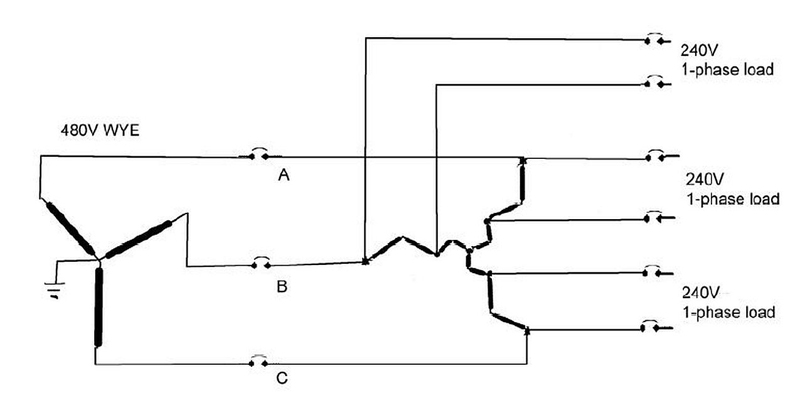Author:
Robert W. Johnson, Chief Engineer, Platform Development and Intellectual Property, Eaton
Date
02/13/2013
The most common options for increasing data-center energy efficiency, including elimination of the PDU (power-distribution unit) and converting to DC power, require disruptive, expensive, and time-consuming changes. As a result, they are best deployed in new facilities instead of existing ones. Adopting the higher distribution voltages commonly used in European countries, however, potentially offers North-American data-center operators a means of boosting efficiency in an existing facility without significantly affecting operations or sacrificing the familiarity of AC distribution. Yet while European distribution voltages are suitable for most U.S. IT loads, the load voltage they deliver is 17% less than what is provided by 480/277-V distribution (i.e. 415/240 V). Moreover, significantly more copper conductor is required to support the same kVA load. A better alternative would be to distribute 480-V delta to the point of use and then convert it to 480/277-V or 400/230-V distribution. At present, however, such an arrangement would require specialized transformers to provide the final distribution voltages. The dilemma is that most of the U.S. has 480-V delta source distribution. Even when the 480-V source is wye, the neutral is not usually supplied with the source conductors and instead is kept at the HV to LV transformation location. There are, however, two new methods that could potentially overcome this quandary. First proposed method Transformers that utilize the auto-zigzag construction can perform the delta to wye transformation without the efficiency loss of an isolation transformer (figure 1). Auto-zigzag construction provides the common functions of zigzag grounding autotransformer and autotransformer. It also provides a voltage transformation and establishes a stable neutral from the 3-wire delta input regardless of phase-to-neutral loading, including 100% imbalance. The combined structure is very efficient, improves load balance to the mains, and has the benefit of harmonic mitigation from the distribution source. It also establishes a local load neutral that can isolate load groups in larger deployments. Unfortunately, the current NEC (US national electrical code) does not allow auto-zigzag construction. If we could overcome the limitations of NEC Articles 450, 210.9, and 250.36 the autotransformer would provide an efficient and effective transformation from the 480-V delta to 400/230-V wye distribution. The installation would need to meet the following characteristics: • Source is 480-V delta • Ground resistors are used to connect derived neutral to ground • Monitoring of the ground resistor voltage causes an alarm to sound if excessive voltage is detected • Breaker protection for the auto-zigzag transformer opens three source phases simultaneously • Loads have two-pole breakers A 650-kVA auto-zigzag transformer of this construction has been successfully tested. This construction has a 1.5% impedance versus 5.75% for a typical isolation transformer and the efficiency of an autotransformer.

Second proposed method As discussed above, European distribution voltages can support most IT loads without specialized power supplies. However, IT loads generally have a single-phase input voltage requirement. Although the typical European distribution is a wye with a neutral, there is no technical reason to provide a common neutral voltage to support single-phase loads other than the reduction in the number of conductors required. Modifying the standard auto-zigzag transformer structure so that it supplies power to the load as three separate 240-V single-phase circuits gives us similar performance in a manner that the NEC does not specifically prohibit (figure 2). On the other hand, it's not explicitly permitted either. That ambiguity ultimately leaves the decision as to whether data centers can use the modified auto-zigzag structure up to the various authorities having jurisdiction across the country, with results that are hard to predict. Employing the modified auto-zigzag structure will therefore remain risky until the NFPA (National Fire Protection Association), which publishes the NEC, updates the code. While not simple, however, updating the NEC is likely to be quicker, easier, and less expensive in the long run than making the kind of wholesale data-center infrastructure changes required by efficiency schemes that involve switching from AC to DC distribution. Organizations seeking to increase data-center efficiency have a variety of options. In North America, those with the biggest impact generally entail distributing power at increased voltages. Data-center designers can achieve this goal using either AC or DC power. However, while both approaches offers roughly the same efficiency gains, DC-based distributions can expose data-center operators to a variety of technical obstacles, including coordination of DC-DC supply-holdup time versus fault-clearing time and selecting fault-protection devices for all conditions. Therefore, companies that wish to use DC distribution should first familiarize themselves with the associated obstacles and verify that they have workable countermeasures for each of them. Alternatively, if the appropriate authorities can be persuaded to update the NEC, data center managers can use auto-zigzag transformers to enjoy the efficiency benefits of high-voltage distribution without DC distribution's added costs and complexities. Eaton